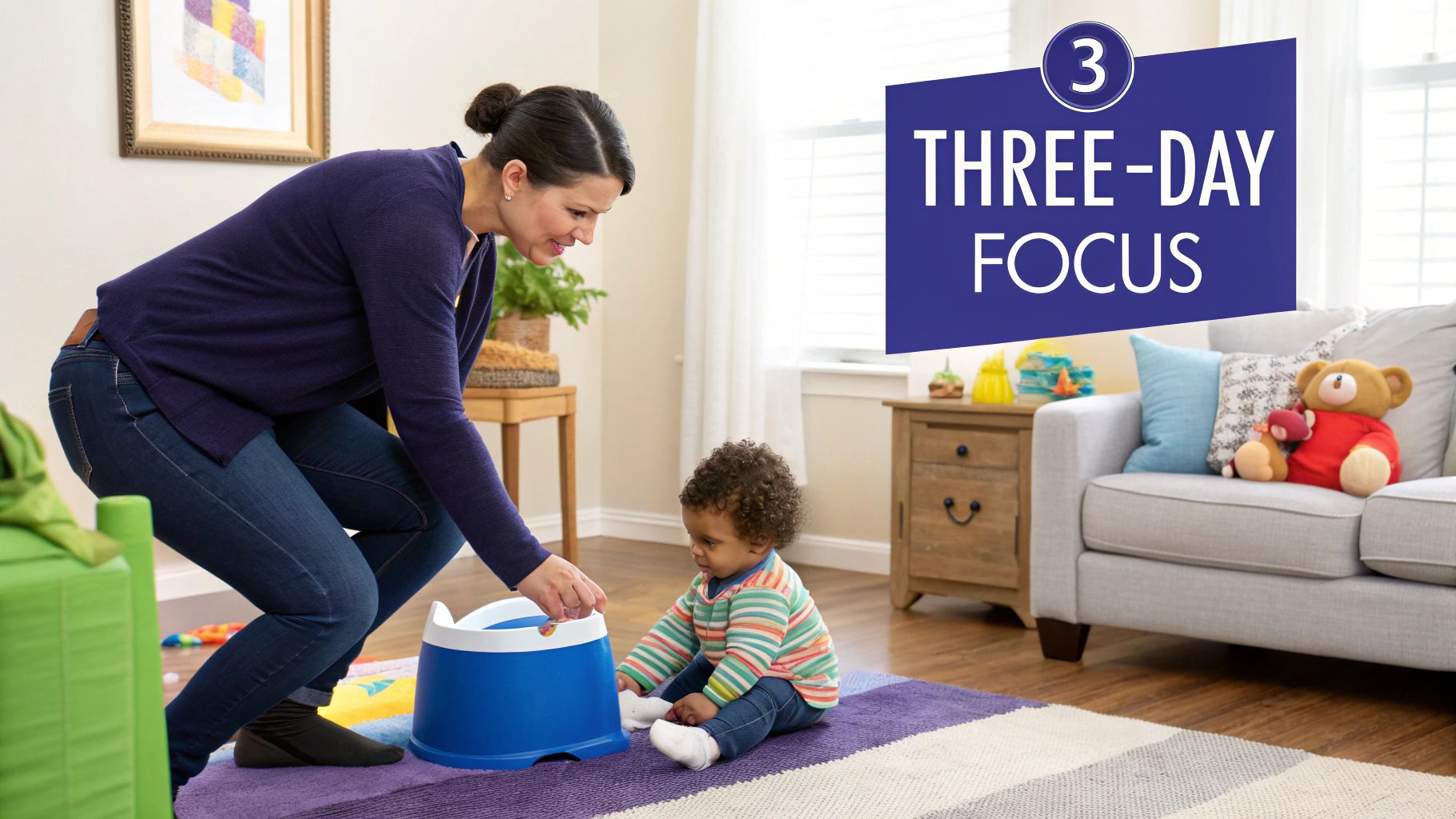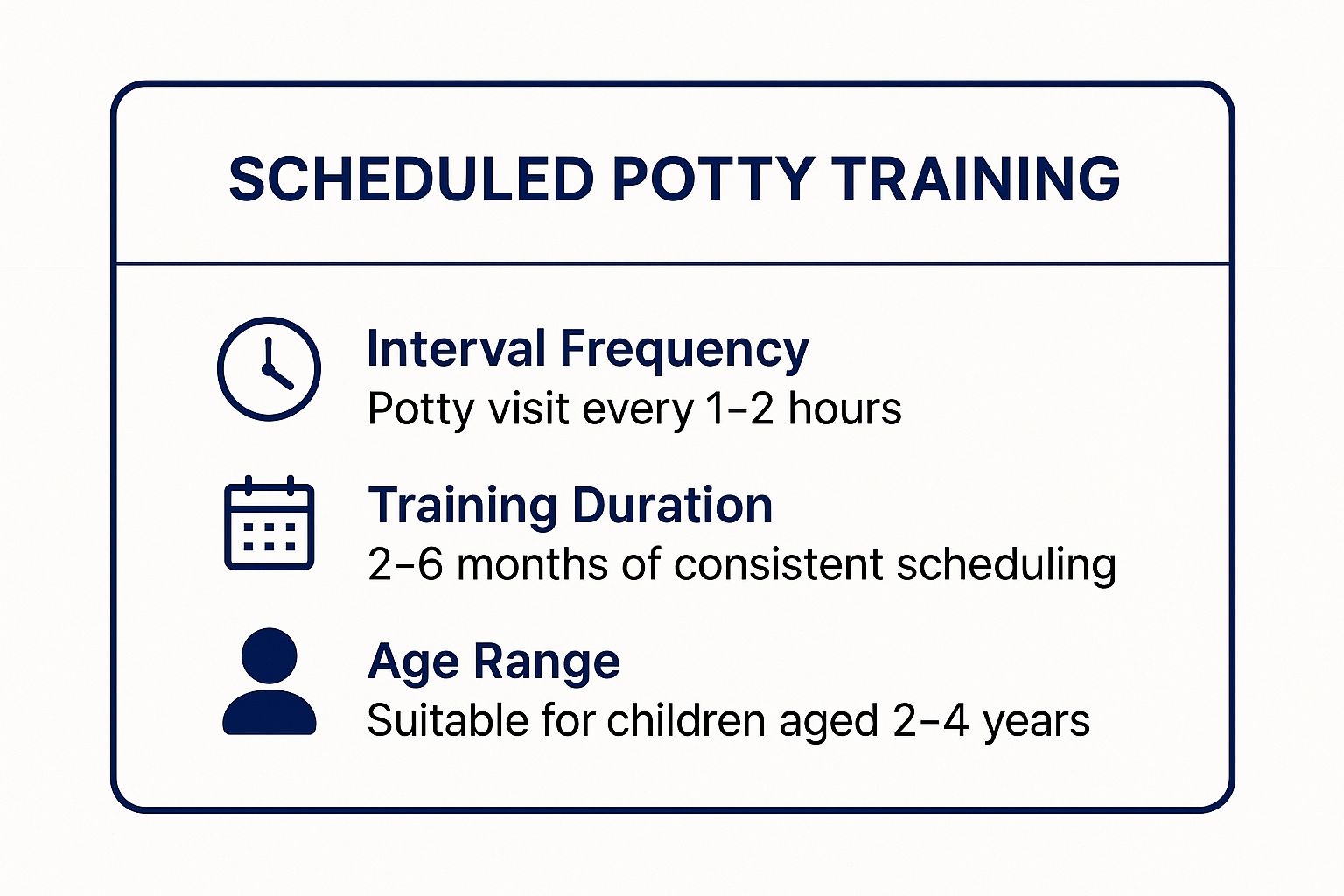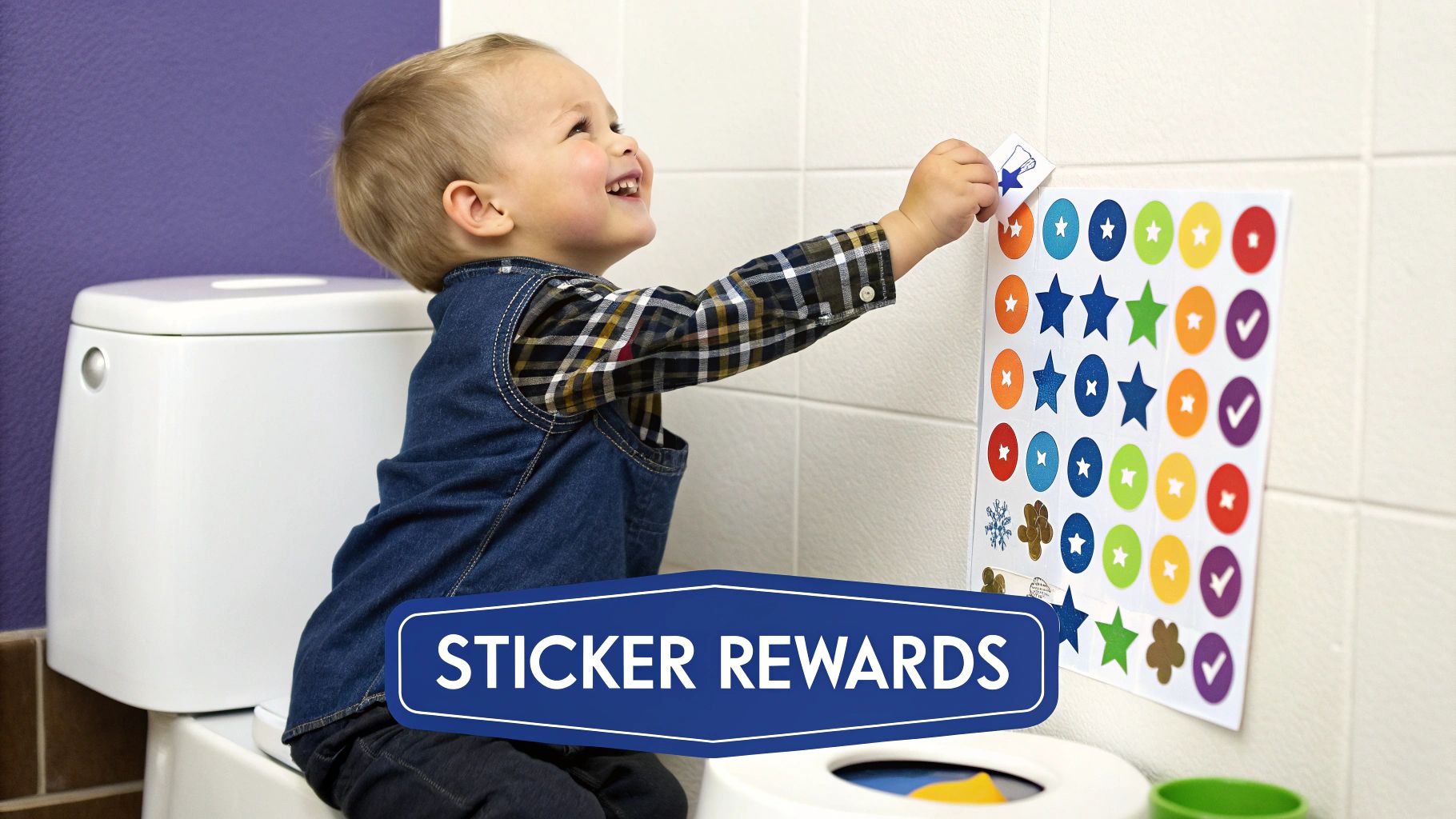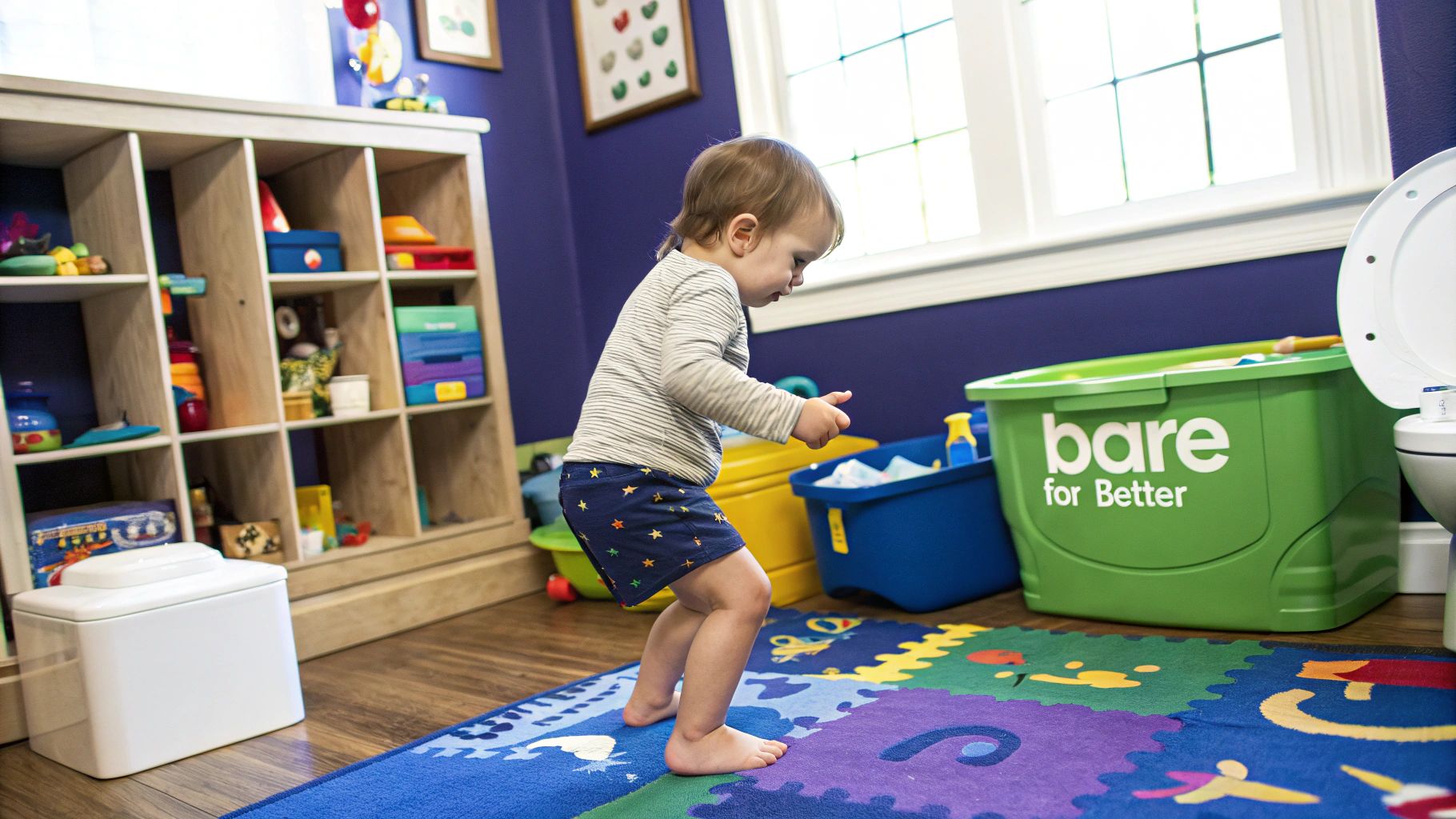Your Guide to Choosing the Right Potty Training Path
Navigating the world of potty training can feel overwhelming, with countless strategies and philosophies to consider. How do you determine which approach is right for your child and your family? The most important thing to understand is that there is no single, universally perfect solution. A child's unique temperament, their specific stage of developmental readiness, and your family's daily lifestyle are all critical factors that will influence the outcome.
This comprehensive guide is designed to cut through the noise and empower you with clear, actionable information on the most popular and effective potty training methods. We will explore a wide range of options, from intensive, rapid techniques like the Three-Day Method to more gentle, long-term strategies such as the Child-Led approach.
Inside, you will find a detailed breakdown of each method, complete with step-by-step instructions, pros and cons, and practical tips for implementation. Our goal is to replace parental confusion with confidence, equipping you to select a method that not only aligns with your parenting style but also sets your toddler up for a successful and positive transition out of diapers. Let’s dive into the options and find the ideal path for this major milestone.
1. Three-Day Method
The Three-Day Method is one of the most popular and intensive potty training methods, promising rapid results by dedicating a long weekend to focused, consistent training. Popularized by authors like Lora Jensen and Brandi Brucks, this approach requires parents to clear their schedules, stay home, and fully immerse their child in the process. The core idea is to move directly from diapers to underwear, creating a new normal and helping the child develop muscle memory through constant repetition.

How It Works
This method operates on an all-or-nothing principle. On day one, diapers are ceremoniously thrown away, and the child often goes bottomless or wears underwear. The parent's job is to watch the child like a hawk for signs they need to go-such as fidgeting, squatting, or grabbing themselves-and then rush them to the potty. The goal is to catch every pee and poop in the potty, celebrating successes enthusiastically. By feeling the sensation of an accident without a diaper to absorb it, children learn the cause-and-effect relationship more quickly.
Who It's For
The Three-Day Method is particularly effective for children between 20 and 36 months who are showing clear signs of readiness. This includes staying dry for longer periods, showing interest in the toilet, and being able to communicate their needs. It's a great fit for parents who can dedicate three uninterrupted days and prefer a swift, decisive approach rather than a gradual one.
Pros and Cons
Pros:
- Fast Results: Many parents report significant progress, even full training, within the three-day window.
- Clear Process: The method is straightforward and eliminates the confusion of transitioning between diapers and underwear.
- Builds Strong Habits: The intense focus helps solidify new toilet habits quickly.
Cons:
- High-Effort: Requires 100% parental attention and can be exhausting.
- Messy: Accidents are an expected part of the learning process, so be prepared for cleanup.
- Potential for Stress: The high-stakes nature can feel stressful for both parent and child if progress is slow.
2. Gradual/Child-Led Method
The Gradual/Child-Led Method is a patient, low-pressure approach that prioritizes the child's developmental readiness and emotional comfort over a strict timeline. Championed by experts like pediatrician Dr. T. Berry Brazelton and often aligned with recommendations from the American Academy of Pediatrics, this philosophy trusts that children will learn to use the potty when they are physically and emotionally prepared. Rather than forcing the issue, parents act as supportive guides, introducing the potty and creating a positive, encouraging environment.
How It Works
This method unfolds organically based on the child's cues. It begins with gentle introductions to the concept of using the toilet. Parents might place a potty in the bathroom, read books about it, and allow the child to observe family members. There is no pressure to perform. The transition from diapers to underwear happens slowly, perhaps starting with an hour of underwear time a day and increasing as the child shows more interest and has more success. The key is to follow the child's lead, celebrating progress without punishing or shaming accidents.
Who It's For
The Gradual/Child-Led approach is ideal for parents who value a low-stress process and are not in a rush to meet a deadline, such as starting preschool. It is particularly effective for children who are sensitive, anxious, or have shown resistance to more structured potty training methods. It allows a child who might show interest at 18 months but isn't fully ready until age 3 to progress at their own pace. Many Montessori and child-centered educational philosophies embrace this approach for its respect for the child's natural timeline.
Pros and Cons
Pros:
- Low Stress: Reduces anxiety and power struggles for both the child and parent, fostering a more positive learning experience.
- Follows Natural Development: Ensures the child is truly ready, which can lead to fewer long-term setbacks.
- Promotes Autonomy: Empowers the child by giving them a sense of control over their own body and learning process.
Cons:
- Long Timeline: This method can take months or even a year, which may not work for families needing a quick solution.
- Requires Patience: Parents must be willing to wait for their child to take the lead, which can be challenging.
- Inconsistent Progress: Progress can be slow and sporadic, with periods of advancement followed by regressions.
3. Scheduled Potty Training
Scheduled Potty Training is a structured, routine-based approach that relies on consistency and repetition. Instead of waiting for a child to show signs of needing to go, the parent takes them to the potty at regular, predetermined intervals throughout the day. This method, often utilized by Applied Behavior Analysis (ABA) practitioners and special education specialists, helps establish a predictable toilet routine and teaches children to become more aware of their body's natural elimination patterns. It's particularly effective for creating structure, which many children thrive on.
This summary box highlights the core principles of the Scheduled Potty Training method for quick reference.

As the data suggests, this is a longer-term strategy that hinges on frequent, consistent potty visits over several months.
How It Works
The core of this method is the schedule. A parent or caregiver creates a fixed timetable for potty breaks, such as every 60 or 90 minutes. When the time comes, the child is taken to the toilet and encouraged to sit for a few minutes, whether they feel the urge or not. This consistent practice helps the child's brain and body connect the act of sitting on the potty with the function of peeing and pooping. The goal is to create so many opportunities for success that the routine becomes second nature.
Who It's For
This method is an excellent choice for children who benefit from clear routines and predictability, including many children on the autism spectrum or those with other developmental needs. It’s also highly practical for daycare settings and for families with multiple children, as the fixed schedule simplifies managing everyone's needs. Parents who appreciate structure and are looking for a less-intensive, gradual approach often find success with scheduled potty training, as it reduces the pressure of constant, hawk-like observation.
Pros and Cons
Pros:
- Highly Structured: The predictable routine can be comforting for children and easier for parents to manage.
- Reduces Accidents: By preempting the need to go, scheduled trips can significantly reduce the number of accidents.
- Effective for a Wide Range of Children: Works well for neurotypical children and is a go-to method for many with special needs.
Cons:
- Longer Timeline: This is a gradual method and typically takes longer than intensive approaches like the three-day method.
- Less Child-Led: The process is initially parent-driven, which may not teach the child to independently recognize their body's signals as quickly.
- Can Be Inflexible: Sticking to a strict schedule can be challenging during outings or disruptions to the daily routine.
4. Reward-Based Training
Reward-Based Training is a motivational approach that leverages the power of positive reinforcement to encourage potty use. Rooted in behavioral psychology principles, this method uses tangible incentives to make the potty training process exciting and goal-oriented for a child. The idea is to associate using the toilet with a positive outcome, making the child more eager to repeat the behavior. It’s a flexible system that can be tailored to what specifically motivates your toddler, from a simple sticker to a coveted toy.

How It Works
This method involves creating a system where a child earns a reward for achieving potty-related milestones. This can be as simple as getting one small treat for every successful pee or poop in the potty, or it can be a more structured system like a sticker chart. For example, a child might earn a sticker for each success, and after collecting a certain number of stickers, they earn a larger prize, like a trip to the park or a new toy. The key is consistency and ensuring the reward is given immediately after the desired action to create a strong connection.
Who It's For
Reward-Based Training is ideal for goal-oriented toddlers who respond well to praise and tangible incentives. It's particularly useful for children who understand cause-and-effect but may lack the internal motivation to start using the potty consistently. This method can also help break through resistance or plateaus in the training process. For parents looking to add structure and fun, a gadget like a potty training watch (buy it in Amazon here) can serve as a great complementary tool, providing timed reminders that create more opportunities for a child to earn a reward.
Pros and Cons
Pros:
- Highly Motivational: Rewards can create genuine excitement and a desire to use the potty.
- Flexible and Customizable: Parents can choose rewards that best suit their child's interests and their own parenting philosophy.
- Positive Focus: The system emphasizes success and positive behavior, which can boost a child's confidence.
Cons:
- Potential for Bribery: There's a fine line between a reward and a bribe; the focus should remain on celebrating achievement.
- Fading the Rewards: It can be challenging to phase out the reward system once the habit is established.
- Not All Kids are Motivated by Rewards: Some children may not respond to this type of external incentive.
5. Naked Training Method
The Naked Training Method is a straightforward approach that removes the biggest barrier to potty awareness: the diaper. This method involves having your child go without diapers, pull-ups, or even pants for a set period, typically at home. The core principle is that without the familiar absorbency of a diaper, a child immediately feels the sensation of urinating or defecating. This direct, tangible feedback helps them quickly make the crucial connection between the urge to go and the physical result, encouraging them to seek out the potty.

How It Works
This method operates on the idea of creating hyper-awareness. To start, you'll choose a period, often a long weekend, where you can stay home. The child remains completely naked from the waist down in a designated, easy-to-clean area of the house. The potty is kept in plain sight and is easily accessible at all times. The parent’s role is to observe for cues and gently guide the child to the potty when they see signs of an impending need. Accidents are treated as learning opportunities, not failures, allowing the child to understand the cause and effect without any shame.
Who It's For
The Naked Training Method is ideal for children who are just beginning their potty training journey and may not yet recognize their body's signals. It's especially popular with parents using philosophies like the one in Jamie Glowacki's Oh Crap! Potty Training, which uses a "bottomless" phase as its first block of learning. This approach works well for families who can dedicate a few days to staying home and are comfortable with the inevitable messes. It is often most practical during warmer months when being unclothed is more comfortable for the child.
Pros and Cons
Pros:
- Fast Connection: Children make the mind-body connection very quickly when they can see and feel what is happening.
- No Confusion: It eliminates the crutch of diapers or pull-ups, which can feel similar to diapers and send mixed signals.
- Cost-Effective: There is no need to buy special training pants or other transitional products.
Cons:
- Very Messy: This is by far the biggest drawback; you must be prepared for pee and poop on your floors.
- Requires Containment: You will need to confine your child to a specific area of the home with protected surfaces.
- Not Practical for Outings: This method is strictly for at-home use, requiring a transition to clothes before venturing out.
6. Elimination Communication (EC)
Elimination Communication (EC), often referred to as "natural infant hygiene," is a method that starts in infancy, long before traditional potty training. Popularized in the West by authors like Ingrid Bauer, it’s based on the idea that babies are born with an instinct to not soil themselves and communicate their elimination needs from birth. Parents learn to recognize these subtle cues-such as grunting, squirming, or pausing an activity-and hold their baby over a potty or toilet to relieve themselves. This approach treats diapers as a backup rather than a full-time toilet.
How It Works
The core of EC is observation and response. Parents spend time learning their baby’s unique signals and natural timing, such as upon waking, after feeding, or during transitions. When a cue is noticed, the parent quickly holds the baby in a secure, squat-like position over a small potty or toilet and often uses a consistent cue sound (like "psss"). The goal isn't perfection but communication. This method fosters a deep connection and helps the baby maintain body awareness, making the eventual transition to independent toilet use more of a natural progression than a training process.
Who It's For
EC is ideal for parents who can commit to being highly attuned to their baby's needs from a very early age, often from birth to around 12 months. It's a great fit for caregivers who are with their baby for most of the day, such as stay-at-home parents or those who work from home. It also appeals to families interested in a more natural, gentle approach that reduces diaper usage and waste. If you’re curious about how to introduce these concepts in a gentle way, you can discover more in the Benny Learns to Potty ebook.
Pros and Cons
Pros:
- Strengthens Bond: The constant observation and communication can deepen the parent-child connection.
- Reduces Diaper Use: Can significantly decrease the number of diapers used, saving money and reducing environmental impact.
- Earlier Independence: Many EC babies achieve toilet independence earlier and more gently than with other potty training methods.
Cons:
- High-Commitment: Requires significant time and attention, which can be challenging for busy or working parents.
- Steep Learning Curve: It takes time to learn a newborn's cues, and misses are frequent, especially at the start.
- Can Be Misunderstood: Others may not understand the practice, leading to a lack of social support.
7. Boot Camp Method
The Boot Camp Method is an intensive, highly structured approach to potty training that demands military-style precision and unwavering consistency. It shares similarities with faster methods like the three-day approach but elevates the intensity with a rigid schedule and zero-tolerance policy for inconsistency. Popularized by various parenting boot camp programs and some professional potty training consultants, this method requires a short-term, all-in commitment to establish new toileting habits with maximum efficiency.
How It Works
This method operates on a strict, time-based schedule rather than just waiting for readiness cues. For a set period, typically a long weekend, the parent establishes a rigid potty schedule, taking the child to the toilet every 15-20 minutes without fail. The child usually goes bottomless or wears underwear to immediately feel accidents. The parent provides constant supervision, offering praise for successes and maintaining a neutral but firm response to accidents, which involves immediate cleanup and a quick return to the potty. The goal is to condition the child through relentless repetition and a highly predictable routine.
Who It's For
The Boot Camp Method is best suited for older toddlers (closer to 3 years old) who have demonstrated clear signs of physical readiness but may be resistant or unmotivated. It's an effective choice for parents who thrive on structure and can dedicate a few uninterrupted days to intensive training. This approach is not recommended for sensitive children who may find the high-pressure environment stressful or for families who cannot commit to the rigorous, around-the-clock schedule required.
Pros and Cons
Pros:
- Very Structured: The clear, time-based schedule removes guesswork for the parent.
- Potentially Fast: The high intensity can lead to rapid conditioning and quick results for the right child.
- Effective for Resistant Toddlers: The no-nonsense approach can break through a power struggle over potty use.
Cons:
- Extremely Intensive: Requires immense parental energy, focus, and mental fortitude.
- High-Stress Potential: The rigid nature can create anxiety for both the child and the parent.
- Requires Strong Follow-Through: Any lapse in consistency after the initial "boot camp" can undermine progress.
Potty Training Methods Comparison Guide
| Method | Implementation Complexity 🔄 | Resource Requirements ⚡ | Expected Outcomes 📊 | Ideal Use Cases 💡 | Key Advantages ⭐ |
|---|---|---|---|---|---|
| Three-Day Method | High 🔄🔄🔄 | Moderate ⚡⚡ | Quick results 📊📊 | Parents with full-time availability; ages 20-36 months | Rapid habit formation; cost-effective; clear timeline ⭐⭐ |
| Gradual/Child-Led Method | Low to Moderate 🔄🔄 | Low ⚡ | Slow and steady 📊 | Anxious or resistant children; ages 18 months–4 years | Low stress; respects child's pace; builds confidence ⭐ |
| Scheduled Potty Training | Moderate 🔄🔄 | Moderate ⚡⚡ | Preventive reduction in accidents 📊📊 | Daycare, group settings; children 2-4 years | Predictable routine; good for special needs; less reliant on child's cues ⭐⭐ |
| Reward-Based Training | Moderate 🔄🔄 | Moderate to High ⚡⚡⚡ | Motivational acceleration 📊📊 | Motivated children; ages 18 months–4 years | Highly motivating; adaptable; builds enthusiasm ⭐⭐ |
| Naked Training Method | Moderate 🔄🔄 | Low to Moderate ⚡⚡ | Rapid bodily awareness 📊 | Home use in warm climates; ages 18–36 months | Eliminates diaper confusion; quick initial breakthroughs ⭐⭐ |
| Elimination Communication | High 🔄🔄🔄 | High ⚡⚡⚡ | Early potty signals; long term 📊 | Parents able to commit long term; infants to 18 months | Reduces diaper use; strengthens bonding; eco-friendly ⭐⭐⭐ |
| Boot Camp Method | Very High 🔄🔄🔄🔄 | Moderate ⚡⚡ | Very fast but high stress 📊 | Highly committed parents; children 22–36 months | Rapid results; strong habit creation; clear procedure ⭐⭐ |
Your Family's Next Steps to Potty Success
Navigating the landscape of potty training methods can feel like a monumental task, but you are now equipped with a detailed map of the most effective approaches. From the rapid results of the Three-Day and Boot Camp methods to the gentle, child-led pace of Gradual Training and Elimination Communication, you have seen that there is no single "correct" way to achieve diaper freedom. The key takeaway is that the most successful potty training journey is not about rigidly adhering to one doctrine; it is about finding the right fit for your unique child and your family's circumstances.
The methods we have explored, including Scheduled Potty Training, the Naked Method, and Reward-Based systems, all share a common foundation: consistency, patience, and positive reinforcement. Your toddler’s temperament, readiness cues, and learning style are the most critical factors in making your selection. A fiercely independent child might rebel against a strict schedule but thrive with the autonomy offered by a child-led approach. Conversely, a child who loves structure and praise may respond brilliantly to a reward-based system.
Making Your Decision: Actionable Next Steps
Instead of feeling overwhelmed by the options, view them as a flexible toolkit. Your next step is to sit down, perhaps with your partner, and honestly assess your situation.
- Evaluate Your Child: Think about their personality. Are they a creature of habit? Do they resist pressure? Are they highly motivated by praise or tangible rewards? Your observations are the most valuable data you have.
- Assess Your Family’s Capacity: Consider your work schedules, other children, and personal tolerance for messes. A high-intensity method like the Three-Day plan requires a dedicated, uninterrupted block of time that may not be realistic for every family. Be honest about what you can consistently commit to.
- Create a Hybrid Approach: Do not be afraid to customize. You can absolutely blend elements from different potty training methods. For instance, you might use the Naked Method for the first few days to increase awareness, then transition into a Scheduled Potty Training routine supplemented with a reward chart.
The True Value of a Thoughtful Approach
Choosing the right potty training method is about more than just ditching diapers. It is a powerful opportunity to build your child's confidence, foster their sense of independence, and strengthen your parent-child bond. When you approach this milestone with empathy and respect for their pace, you are teaching them that learning new skills is a positive, supported experience. This foundation of trust and encouragement will serve them well long after potty training is a distant memory. Remember to celebrate the small victories, offer grace during setbacks, and trust in the process. With your guidance, your child will proudly master this essential life skill.
As you prepare for this new chapter, having the right gear can make all the difference in creating a comfortable and encouraging environment. For thoughtfully designed baby and toddler essentials that support your family through every milestone, explore the collection at Benny Bradley's. Their products are crafted with the safety, comfort, and practical needs of modern parents and happy toddlers in mind.
